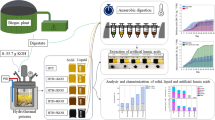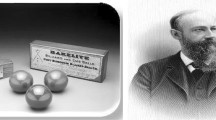Abstract
Nonylphenol can be present in sewage sludge, and this can limit the use of the sewage sludge to amend soil. Composting is one of the most efficient and economical methods of making sewage sludge stable and harmless. The nonylphenol degradation rates during composting with added bulking agents and with aeration applied were studied. Three organic bulking agents (sawdust, corn stalk, and mushroom residue) were added to sewage sludge, and the effects of the bulking agents used and the amount added on nonylphenol degradation were determined. The highest apparent nonylphenol degradation rate (71.6 %) was found for sewage sludge containing 20 % mushroom residue. The lowest apparent nonylphenol degradation rate (22.5 %) was found for sewage sludge containing 20 % sawdust. The temperature of the composting pile of sewage sludge containing 20 % sawdust became too high for nonylphenol to be efficiently degraded, and the apparent nonylphenol degradation rate was lower than was found for sewage sludge containing 10 % sawdust. Increasing the ventilating time from 5 to 15 min increased the apparent nonylphenol degradation rate from 19.7 to 41.6 %. Using appropriate aerobic conditions facilitates the degradation of nonylphenol in sewage sludge, decreasing the risks posed by sewage sludge applied to land. Adding too much of a bulking agent can decrease the amount of the nonylphenol degraded. Increasing the ventilating time and the amount of air supplied can increase the amount of nonylphenol degraded even if doing so causes the composting pile temperature to remain low.





Similar content being viewed by others
References
Abad E, Martínez K, Planas C, Palacios O, Caixach J, Rivera J (2005) Priority organic pollutant assessment of sludges for agricultural purposes. Chemosphere 61(9):1358–1369
Arditsoglou A, Voutsa D (2008) Determination of phenolic and steroid endocrine disrupting compounds in environmental matrices. Environ Sci Pollut R 15(3):228–236
Arslan OC, Parlak H (2007) Embryotoxic effects of nonylphenol and octylphenol in sea urchin Arbacia lixula. Ecotoxicology 16(6):439–444
Banat FA, Prechtl S, Bischof F (2000) Aerobic thermophilic treatment of sewage sludge contaminated with 4-nonylphenol. Chemosphere 41(3):297–302
Belén P, Teresa G, Antoni S (2010) A new control strategy for the composting process based on the oxygen uptake rate. Chem Eng J 165(1):161–169
Capota CD, Deventer B, Zimmermann R-D (2004) The effect of 4-nonylphenol on the pigmentation of Ocimum basilicum (Basil). Environ Sci Pollut Res 11(2):121–125
Chang BV, Liu CL, Yuan SY, Cheng CY, Ding WH (2008) Biodegradation of nonylphenol in mangrove sediment. Int Biodeter Biodegr 61(4):325–330
Chang BV, Lu YS, Yuan SY, Tsao TM, Wang MK (2009) Biodegradation of phthalate esters in compost-amended soil. Chemosphere 74(6):873–877
Chen H, Yan S-H, Ye Z-L, Meng H-J, Zhu Y-G (2012) Utilization of urban sewage sludge: Chinese perspectives. Environ Sci Pollut Res 19(5):1454–1463
Das KC, Xia K (2008) Transformation of 4-nonylphenol isomers during biosolids composting. Chemosphere 70(5):761–768
Eriksson E, Christensen N, Schmidt JE, Ledin A (2008) Potential priority pollutants in sewage sludge. Desalination 226(1–3):371–388
Fountoulakis M, Drillia P, Pakou C, Kampioti A, Stamatelatou K, Lyberatos G (2005) Analysis of nonylphenol and nonylphenol ethoxylates in sewage sludge by high performance liquid chromatography following microwave-assisted extraction. J Chromatogr A 1089(1–2):45–51
González MM, Martín J, Santos JL, Aparicio I, Alonso E (2010) Occurrence and risk assessment of nonylphenol and nonylphenol ethoxylates in sewage sludge from different conventional treatment processes. Sci Total Environ 408(3):563–570
Hao R, Liang P, Zhou Y (2007) Study on translation and conversion behavior of nonylphenol in municipal wastewater treatment China. Water Wastewater 23(1):105–108 in Chinese
Haritash AK, Kaushik CP (2009) Biodegradation aspects of Polycyclic Aromatic Hydrocarbons (PAHs): a review. J Hazard Mater 169(1–3):1–15
Harrison EZ, Oakes SR, Hysell M, Hay A (2006) Organic chemicals in sewage sludges. Sci Total Environ 367(2–3):481–497
Harvey PJ, Campanella BE, Castro PML, Harms H, Lichtfouses E, Schäffner AR, Smrcek S, Werck-Reichhart D (2002) Phytoremediation of polyaromatic hydrocarbons, anilines and phenols Environ. Sci Pollut Res 9(1):29–47
Hua L, Wu W, Liu Yu, Chen Y, McBride MB (2008) Effect of composting on polycyclic aromatic hydrocarbons removal in sewage sludge. Water Air Soil Pollut 193(1–4):259–267
Kim JY, Ryu K, Kim EJ, Choe WS, Cha GC, Yoo I-K (2007) Degradation of bisphenol A and nonylphenol by nitrifying activated sludge. Process Biochem 42(10):1470–1474
Lashermes G, Houot S, Barriuso E (2010) Sorption and mineralization of organic pollutants during different stages of composting. Chemosphere 79(4):455–462
Li C, Ji R, Vinken R, Hommes G, Bertmer M, Schäffer A, Corvini PFX (2007) Role of dissolved humic acids in the biodegradation of a single isomer of nonylphenol by Sphingomonas sp. Chemosphere 68(11):2172–2180
Li ZY, Zhang HL, Gibson M, Liu P (2012) An evaluation of the combined effects of phenolic endocrine disruptors on vitellogenin induction in goldfish Carassius auratus. Ecotoxicology 21(7):1919–1927
Lian J, Liu JX, Wei YS (2009) Fate of nonylphenol polyethoxylates and their metabolites in four Beijing wastewater treatment plants. Sci Total Environ 407(14):4261–4268
Lu J, Jin Q, He Y (2008) Biodegradation of nonylphenol polyethoxylates by denitrifying activated sludge. Water Res 42(4–5):1075–1082
Moeller J, Reeh U (2003) Degradation of nonylphenol ethoxylates (NPE) in sewage sludge and source separated municipal solid waste under bench-scale composting conditions. Bull Environ Contam Toxicol 70(2):248–254
Oleszczuk P (2006) Influence of different bulking agents on polycyclic aromatic hydrocarbons (PAHs) disappearance during sewage sludge composting. Water Air Soil Poll 175(1–4):15–32
Pakou C, Kornaros M, Stamatelatou K, Lyberatos G (2009) On the fate of LAS, NPEOs and DEHP in municipal sewage sludge during composting. Bioresour Technol 100(4):1634–1642
Patureau D, Delgenes N, Delgenes J (2008) Impact of sewage sludge treatment processes on the removal of the endocrine disrupters nonylphenol ethoxylates. Chemosphere 72(4):586–591
Qiao Y, Zhang J, Zhang Y, Chen M, Yang M, Xu D (2007) Occurrence of alkylphenol and bisphenol-A in sewage sludge in a north China city. Environ Chem 6(5):671–674 (in Chinese)
Scott-Fordsmand JJ, Krogh PH (2004) The influence of application form on the toxicity of nonylphenol to Folsomia fimetaria (Collembola: Isotomidae). Ecotoxicol Environ Saf 58(3):294–299
Soares A, Guieysse B, Jefferson B, Cartmell E, Lester JN (2008) Nonylphenol in the environment: a critical review on occurrence, fate, toxicity and treatment in wastewaters. Environ Int 34(7):1033–1049
Sui Q, Huang J, Yu G (2009) Priority analysis for controlling endocrine disrupting chemicals in municipal wastewater treatment plants of China. Environ Sci 30(2):384–390 (in Chinese)
Venkatesan AK, Halden RU (2013) National inventory of alkylphenol ethoxylate compounds in U.S. sewage sludges and chemical fate in outdoor soil mesocosms. Environ Pollut 174:189–193
Wang Y, Yang Z, Li Z, Ren H (2011) Degradation and adsorption of nonylphenol in soils. J Agroenviron Sci 30(8):1561–1566 (in Chinese)
Wu H, Liang S, Wei C (2006) Research progresses on environmental behavior and biodegradation of nonylphenol. Environ Protect Chem Ind 26(1):31–34 (in Chinese)
Ying GG (2006) Fate, behavior and effects of surfactants and their degradation products in the environment. Environ Int 32(3):417–431
Yuan SY, Yu CH, Chang BV (2004) Biodegradation of nonylphenol in river sediment. Environ Pollut 127(3):425–430
Zhang J, Yang M, Zhang Y, Chen M (2008) Biotransformation of nonylphenol ethoxylates during sewage treatment under anaerobic and aerobic conditions. J Environ Sci-China 20(2):135–141
Zheng GD, Gao D, Chen TB, Luo W (2007) Stabilization of nickel and chromium in sewage sludge during aerobic composting. J Hazard Mater 142(1–2):216–221
Acknowledgments
This study was supported by the National Natural Science Foundation of China (Grant No. 41101463, 41371455).
Author information
Authors and Affiliations
Corresponding author
Ethics declarations
Conflict of interest
The authors declare that they have no conflict of interest.
Rights and permissions
About this article
Cite this article
Zheng, G., Chen, T., Yu, J. et al. Impact of composting strategies on the degradation of nonylphenol in sewage sludge. Ecotoxicology 24, 2081–2087 (2015). https://doi.org/10.1007/s10646-015-1558-x
Accepted:
Published:
Issue Date:
DOI: https://doi.org/10.1007/s10646-015-1558-x




